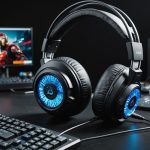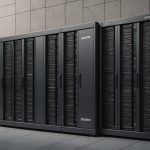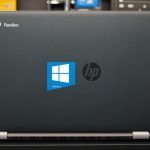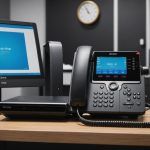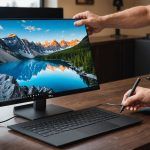Unlocking Ultimate Connectivity: A Complete Guide to Optimizing Your Dell XPS 13 with Thunderbolt 3 Dock Setup
In the world of modern computing, staying connected and productive is more crucial than ever. For Dell XPS 13 users, one of the most powerful tools to enhance your laptop’s capabilities is the Thunderbolt 3 dock. This comprehensive guide will walk you through the process of setting up, optimizing, and troubleshooting your Thunderbolt 3 dock, ensuring you get the most out of your device.
Understanding Thunderbolt 3 Technology
Before we dive into the setup and optimization, it’s essential to understand what makes Thunderbolt 3 technology so powerful. Thunderbolt 3 is a significant advancement in connectivity, merging data transfer, charging, and video output into a single compact port using the versatile USB-C connector. With speeds of up to 40 Gbps, it provides ample bandwidth for multiple peripherals, delivering faster data exchanges and more efficient workflows[1].
In the same genre : Ultimate Guide to Configuring VoIP: Seamlessly Connect Cisco SPA112 with Synology NAS
For Dell XPS 13 users, Thunderbolt 3 docks are indispensable. These docks expand the device’s connectivity options without compromising the laptop’s sleek design. Here are some key benefits of using a Thunderbolt 3 dock:
- High-Speed Data Transfer: Transfer data at speeds of up to 40 Gbps, making it ideal for high-bandwidth tasks.
- Multi-Display Support: Connect up to three FHD displays, two 4K displays, or one 5K display at 60Hz, enhancing your visual workspace[3].
- Power Delivery: Charge your laptop while connecting other devices, ensuring your device stays powered throughout the day.
- Versatile Connectivity: Access a wide variety of ports, including USB, HDMI, Ethernet, and more, all through a single cable.
Setting Up Your Thunderbolt 3 Dock
Setting up your Thunderbolt 3 dock is straightforward but requires some attention to detail to ensure optimal performance.
Step-by-Step Dock Setup
-
Compatibility Check:
Ensure your dock is compatible with your Dell XPS 13. Popular options include the Dell WD19, WD19DC, and WD19TB docks, which offer various connectivity options such as USB-C, dual USB-C, and Thunderbolt 3[5]. -
Physical Connection:
Connect the dock to your laptop using the USB-C cable, which should fit snugly into the Thunderbolt 3 port. Make sure the cable is securely connected to both the dock and the laptop. -
Firmware Update:
Update the dock’s firmware before proceeding. This can usually be done through the manufacturer’s website. For example, Dell users can download the latest updates for the WD19 dock from Dell Support[5]. -
Power Connection:
Connect the dock’s power adapter and ensure it is properly functioning. For docks like the Dell TB16, a minimum of 180-watt power adapter is required[3].
Adjusting Settings on the Dell XPS 13
After the physical setup, navigate to your Dell XPS 13 settings to ensure everything is configured correctly.
-
Enable Thunderbolt Technology:
Go to your BIOS settings and ensure that Thunderbolt technology is enabled. This step is crucial for the dock to function properly[1]. -
System Updates:
Ensure your system is up to date. Download and install any necessary updates for both your laptop and the dock to maintain compatibility and performance[5].
Expert Tips for Maximizing Connectivity
To get the most out of your Thunderbolt 3 dock, here are some expert tips:
Regular Maintenance
- Check Connections: Regularly check all connections to ensure cables fit securely and inspect ports for any signs of wear or damage.
- Dust-Free Environment: Keep the dock and your Dell XPS 13 dust-free to mitigate connectivity issues over time[1].
Choosing the Right Dock
- Additional Ports: Select a dock that offers additional ports tailored to your needs, such as HDMI for external displays or more USB ports for peripherals.
- Power Requirements: Ensure the dock’s power output meets the requirements of your Dell XPS 13 to avoid charging inconsistencies[1].
Advanced Configuration
- Utilize Additional Ports Effectively: Maximize the utility of additional ports on your dock. Assign ports for quick access to essential peripherals like USB devices or an HDMI monitor.
- Customize Display Settings: Access display settings in your operating system to manage screen resolution and orientation. This can greatly enhance your productivity by expanding your visual workspace[1].
Troubleshooting Common Issues
Despite the robust design of Thunderbolt 3 docks, issues can arise. Here’s how to troubleshoot common problems:
Connection Problems
- Check Cables: Ensure all cables are securely connected and inspect the ports on both the dock and your Dell XPS 13 for visible damage.
- Firmware and Drivers: Keep the dock’s firmware and drivers updated. Regular updates provide bug fixes and compatibility enhancements[1].
Power Delivery Issues
- Power Supply Check: Ensure that your dock’s power supply is properly connected and functioning. Verify that the dock’s power output meets the requirements of your Dell XPS 13.
- Alternate Power Source: If your laptop isn’t charging, try using an alternate power cable or source[1].
Enhancing Functionality with Configuration
Optimizing your Thunderbolt 3 dock setup can significantly enhance your productivity.
Utilizing Additional Ports Effectively
Here’s a detailed list on how to maximize the utility of additional ports:
-
USB Ports:
-
Assign USB ports for high-traffic devices like external drives to ensure swift data transfer.
-
Use front USB ports for quick access to frequently used devices.
-
Utilize rear USB ports for less frequently used devices to keep your workspace organized[1].
-
Display Ports:
-
Connect multiple monitors to expand your visual workspace.
-
Use HDMI ports for external displays, and consider using active display port to HDMI adapters if necessary[4].
-
Ethernet Port:
-
Use the Gigabit Ethernet port for a stable and high-speed internet connection, especially in environments where Wi-Fi may be unreliable[3].
Customizing Display Settings
Customizing your display settings is crucial for seamless integration of multiple screens with your Dell XPS 13.
- Screen Resolution and Orientation:
- Access display settings in your operating system to manage screen resolution and orientation.
- Set the correct display parameters to enhance your productivity by expanding your visual workspace[1].
Comparative Analysis of Popular Thunderbolt 3 Docks
Here is a comparative table of some popular Thunderbolt 3 docks, highlighting their key features:
| Dock Model | Connectivity Options | Display Support | Power Delivery | Additional Ports |
|---|---|---|---|---|
| Dell WD19 | USB-C, Dual USB-C, Thunderbolt 3 | Up to 2 4K displays | Up to 90W | USB-A, USB-C, HDMI, Ethernet[5] |
| Dell TB16 | Thunderbolt 3 | Up to 3 FHD displays or 2 4K displays | Up to 180W | USB-A, USB-C, HDMI, Ethernet, DisplayPort[3] |
| CalDigit TS4 | Thunderbolt 4 | Up to 2 6K displays or 1 8K display | Up to 98W | USB-A, USB-C, HDMI (with adapter), Ethernet[4] |
| Baseus 10-in-1 | USB-C | Up to 2 4K displays | Up to 100W | USB-A, USB-C, HDMI, Ethernet, SD Card Slot[4] |
Practical Insights and Actionable Advice
Here are some practical tips to help you make the most out of your Thunderbolt 3 dock:
- Label Your Devices: Label your devices to quickly identify them, enabling effortless interchangeability while maintaining a streamlined setup.
- Use Quality Cables: Use high-quality cables to prevent issues such as data loss or connectivity problems.
- Keep Your Workspace Organized: Ensure the dock is properly anchored in the Thunderbolt 3 port and keep your workspace organized to maximize the benefits of your setup[1].
Setting up and optimizing your Thunderbolt 3 dock with your Dell XPS 13 is a straightforward process that can significantly enhance your productivity and connectivity. By following these expert tips and troubleshooting common issues, you can unlock the full potential of your device.
As Dell emphasizes, “The right dock can seamlessly extend your device’s capabilities without unnecessary extras.” By choosing the right dock, maintaining it properly, and configuring it to your needs, you can transform your workspace into a high-performance hub that supports your business and personal needs efficiently[1].
Whether you’re a small business owner, a freelancer, or simply someone who values high-performance computing, a well-configured Thunderbolt 3 dock is an indispensable tool. So, take the time to set it up correctly, and you’ll be amazed at how it can elevate your work experience.


